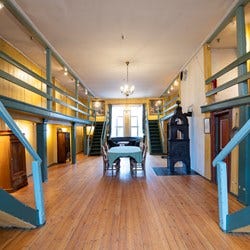The Challenge of Caring for Poor Older Women Have Always Been With Us
But how we do and do not meet that challenge has changed over time.
I took a wrong turn when visiting Bergen, Norway, recently and happened upon the opening of a small new museum in a preserved almshouse from the 18th century, the Stranges Stiftelse. The charity was actually started in 1609 by a city councilor, Strange Jørgensen, who funded the building and the foundation that supported it from the proceeds of the sale of a ship. The original structure burned down in a 1702 fire that destroyed most of Bergen. The existing building was erected in 1751 and operated until 1972.
The almshouse was created for elderly women, mostly “spinsters,” but some old widows as well. At the beginning, it housed 30 women, two each to 15 very small rooms. At a later date they changed the housing to one woman per room, still very tight.
No doubt the 18th century occupants were shorter than today’s Norwegians. I had to stoop and hit my head on a later addition to the premises, a sprinkler attached to the ceiling. Though in checking, they were not as short as I would have thought. According to one study, poorer women in medieval Norway averaged five feet, three inches, just two inches shorter than Norwegian women today. (Wealthier women were taller.) Still, that would have been short enough not to have had to stoop in their quarters (or have hit their head on the modern sprinkler system).
The challenge of housing and caring for older women without families has been long with us. According to the documentation at the Bergen museum, the Catholic church had cared for the poor until the 16th century reformation. After that such care was taken over by private individuals and charities.
As my father explained in his 1990 book, Risking Old Age in America, in the United States, caring for the destitute of all ages was always a mix of public support and private charity. “In one arrangement, a town would contract with someone to take care of all the poor under a single roof. Here was the forerunner of today’s proprietary nursing home, which from its inception seems to have relied on public funds. [Historian Robert W.] Kelso called it ‘a privately operated almshouse where the profit to the keeper was the object sought.’”
Quality of care was always an issue. “A legislative committee investigating county-run almshouses in the state of New York, for instance, reported in 1856 that most were ‘badly constructed, ill-arranged, ill-warmed and ill-ventilated.’ Furthermore, ‘the rooms are crowded with inmates; and the air, particularly in the sleeping apartments, is noxious.’”
While the cause of the recent tragedy of the fire at the Gabriel House assisted living facility in Fall River has not been determined, it certainly raises questions about how far we have come in the quality of care for older men and women today, especially those who cannot afford private assisted living facilities. Yet the assisted living facility in itself represents the latest trend in caring for seniors and others who need assistance.
Years ago, I served on the board of Goddard House. It now operates an assisted living facility in Brookline, but was created and funded in the 19th century to provide housing for retired women, many of whom had worked for decades for wealthy families on Beacon Hill and in the Back Bay. Its original building on South Huntington Avenue in Jamaica Plain morphed into a nursing home and was ultimately closed when the cost of updating the building to modern standards was unaffordable.
The Bergen almshouse, Goddard House and Gabriel House reflect how care for elderly women (and men) has developed over time. They often didn’t have the economic resources or familial support necessary for their needs after they could no longer be employed, so they had to depend on a mix of private charity and public support, neither of which were ever sufficient to provide decent, much less high-quality, care in most instances.
All of this is still true today. The public has never been willing to pay for the care of the elderly and others who need assistance at levels sufficient to provide all with high quality care in the setting they would prefer. Our Medicaid program that pays for nursing homes, and in some instances for assisted living and home care, is based on the premise that the state will only step in when the person needing care becomes indigent, often due to the cost of privately-paid care.
The extent of even that assistance is often a subject of controversy as we have seen in the debate over President Trump’s “Big Beautiful Bill.” As I recently discussed in a column in The Boston Globe, its Medicaid cuts will strike older women in the United States especially hard.



